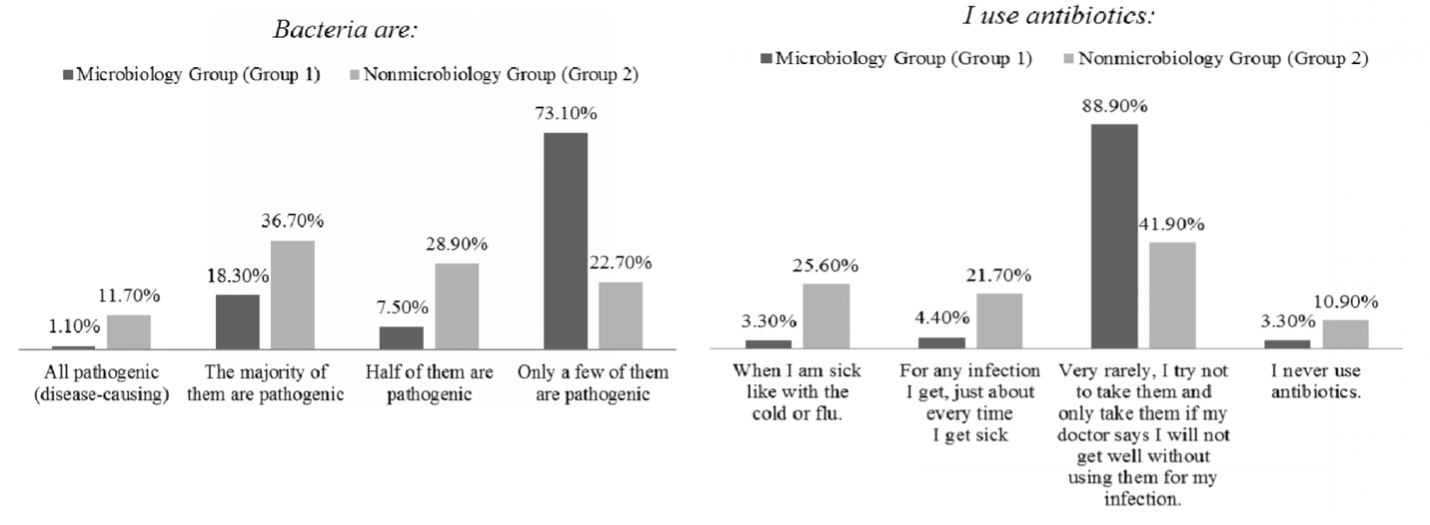By Emma Treco

Why Bacteria?
Throughout my undergraduate career, I have spent much time learning about, thinking about, and discussing microbes, which I don’t mind because I have seen just how cool they are! It is interesting to think about how much I have learned in the past couple of years. For example, before college, the only thing I knew about bacteria was 1) they cause disease and 2) their mitochondria are the powerhouses of the cell.
This is not unlike many others outside of the microbiology community who never received formal microbiology education. Why is that? Because microbiology topics are not included in the United States K-12 curriculum! The inadequate coverage of microbiology in grade school may not seem like a big issue, but it leads to glaring and dangerous knowledge gaps later in life. For example, a survey of University of Illinois at Chicago undergraduates revealed that 21% of those without a microbiology background believed antibiotics should be taken every time one is sick.1 Misconceptions like these are concerning as they lead to the misuse of medication, and therefore public health problems and increased disease-causing bacteria.

Because microbiology is not taught in public schools, individuals must learn about microbes through news sources which heavily emphasize globally significant diseases, antibiotic resistance bacteria, large-scale food contamination, and bioterrorism. This negative focus affects the public perception on microbes, generating public fear and, consequently, creating barriers in microbiology research(2).
I believe to combat this fear, it is important to educate children on the good side of bacteria, such as their benefits in agriculture, biotechnology, energy production, protection from infection by other bacteria, and more. To help ease some of this, I have created an illustrated children’s book, and coloring book version, titled “Day in the Life of a Bacterium” which follows a Staphylococcus Epidermidis bacterium nicknamed S. Epi that lives on your nose and works with your immune system to protect you from “bad” bacteria.
About the Project
In creating “Day in the Life of a Bacterium”, I relied heavily on scientific literature describing the role and importance of skin-resident bacteria, such as “Dialogue between skin microbiota and immunity” by researchers at the National Institute of Allergy and Infectious Diseases(3). I also corresponded with Nina Lorimor-Easely of the Iowa Reading Reseach Center to ensure my writing was suitable for my target audience. Lastly, I worked with bacteriologist, Dr. Theresa Ho from The University of Iowa Carver College of Medicine to confirm the accuracy of the content and set up an in-person event to share my coloring book.



This event took place at the Lincoln Elementary School STEAM night in Iowa City, IA. Here I stood alongside other students from the University of Iowa Department of Microbiology and Immunology to teach elementary schoolers about bacteria through activities such as agar art, viewing bacteria through the microscope, and finally, using the coloring book. Here, I was able to not only showcase my coloring book, but also teach kids about bacteria and their importance.
The illustrated book is available for purchase on Amazon.com (physical copies and kindle version) and will be distributed in the Free Little Libraries throughout Iowa City, IA. The coloring book is available below for downloading and printing.
Click Here to Download Coloring Book!
Sources:
- Movahedzadeh, Farahnaz. “Do You Know Your SH*T? Students’ Awareness, Attitude and Perception about Current and Relevant Events in Microbiology.” British Journal of Applied Science & Technology, vol. 4, no. 16, 2014, pp. 2290–2301., https://doi.org/10.9734/bjast/2014/9315.
- Nester, E.W. “Microbiology in the 21st Century: Where Are We and Where Are We Going?” National Center for Biotechnology Information., 2004, https://doi.org/10.1128/aamcol.5sept.2003.
- Belkaid, Yasmine, and Julia A. Segre. “Dialogue between Skin Microbiota and Immunity.” Science, vol. 346, no. 6212, 2014, pp. 954–959., https://doi.org/10.1126/science.1260144.

